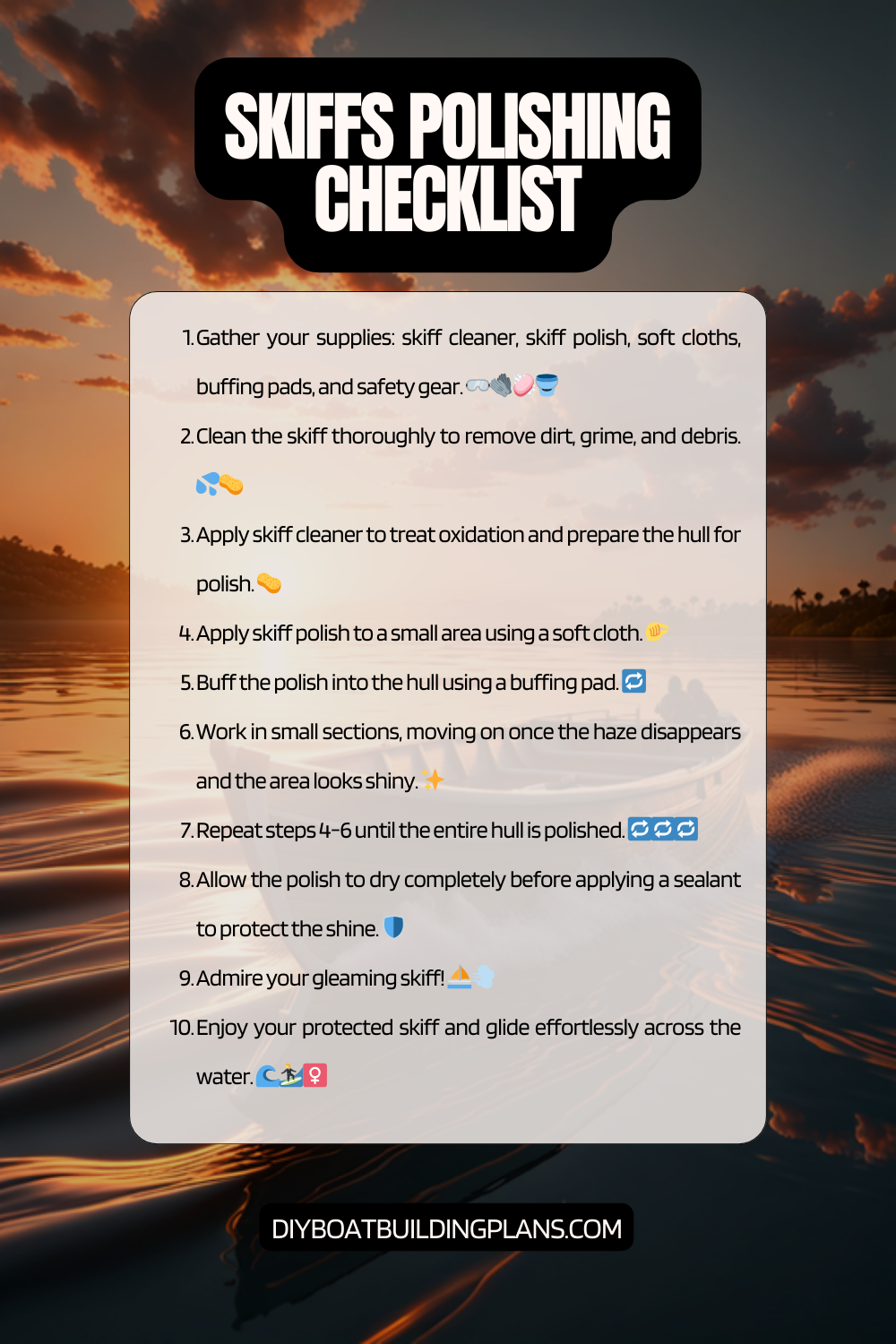Overview of Skiff Polishing Tips
Skiff polishing refers to the process of restoring and maintaining the shine and luster of a skiff’s exterior surface. A skiff is a small, flat-bottomed boat typically used for fishing or recreational purposes. Over time, a skiff’s exterior can become dull and faded due to exposure to various environmental factors such as sunlight, saltwater, and pollutants. Skiff polishing involves using specialized products and techniques to remove oxidation, stains, and other imperfections, resulting in a smooth and glossy finish.
Maintaining a polished skiff is essential for several reasons. Firstly, it provides protection against environmental factors. The sun’s UV rays can cause the paint or gel coat on a skiff to fade and deteriorate over time. By regularly polishing the skiff, a protective layer is created that shields the surface from harmful UV rays, preventing premature aging and damage. Additionally, polishing helps to repel water and prevent the buildup of dirt, salt, and other contaminants that can corrode the skiff’s surface.
Furthermore, skiff polishing enhances the appearance of the boat. A well-polished skiff not only looks more attractive but also gives the impression of being well-maintained. Whether you use your skiff for personal enjoyment or for professional purposes such as charter fishing, having a polished boat can make a positive impression on others. It also contributes to your own pride of ownership and enjoyment of your skiff.
Key Takeaways
- Skiff polishing is important to maintain the appearance and longevity of your boat.
- Choosing the right polishing products and preparing the skiff properly are crucial for achieving a successful polish.
- Different skiff materials require different polishing techniques, so it’s important to know what works best for your boat.
- Common mistakes to avoid include using too much pressure, not using enough product, and not properly cleaning the surface beforehand.
- Regular maintenance and polishing can extend the life of your skiff, but professional polishing services can also be a great option for a more thorough and long-lasting polish.

Importance of Skiff Polishing
In addition to protecting against environmental factors and enhancing appearance, skiff polishing also increases the lifespan of the boat. Regularly polishing your skiff helps to maintain its structural integrity by preventing the accumulation of dirt, grime, and salt that can lead to corrosion or deterioration of materials over time. By removing these contaminants and applying protective coatings, you can significantly extend the life of your skiff.
Moreover, polishing helps to maintain the resale value of your skiff. A well-maintained and polished boat is more likely to attract potential buyers and command a higher price compared to a neglected or dull-looking skiff. By investing time and effort into regular skiff polishing, you are essentially protecting your investment and ensuring that you can enjoy your boat for years to come.
Choosing the Right Polishing Products
When it comes to choosing the right polishing products for your skiff, there are several factors to consider. Firstly, you need to determine the type of material your skiff is made of, as different materials require different types of polish. Fiberglass skiffs, for example, may require a different polish compared to aluminum or wooden skiffs.
Secondly, consider the condition of your skiff’s surface. If it is heavily oxidized or has deep scratches, you may need a more aggressive polish or compound to restore the surface. On the other hand, if your skiff only requires light maintenance, a milder polish or wax may be sufficient.
In the market, there are various types of polishing products available. These include compounds, polishes, waxes, and sealants. Compounds are used for heavy-duty restoration work, while polishes are designed to remove light oxidation and imperfections. Waxes and sealants provide a protective layer that helps to maintain the shine and repel water and contaminants. It is important to choose high-quality products from reputable brands to ensure effective and long-lasting results.
Preparing the Skiff for Polishing
| Task | Time Required | Materials Needed | Tools Required |
| Wash Skiff | 1 hour | Bucket, soap, water, sponge | None |
| Dry Skiff | 30 minutes | Towels | None |
| Apply Compound | 2 hours | Compound, applicator pad | Buffer |
| Polish Skiff | 2 hours | Polish, applicator pad | Buffer |
| Apply Wax | 1 hour | Wax, applicator pad | None |
Before starting the polishing process, it is crucial to properly prepare the skiff’s surface. This involves cleaning the boat thoroughly to remove any dirt, grime, or salt buildup. Use a mild detergent or boat cleaner and a soft brush or sponge to gently scrub the surface. Pay attention to hard-to-reach areas such as corners and crevices.
After cleaning, it is important to remove any existing wax or polish from the skiff. This can be done using a specialized wax or polish remover. Apply the remover to a clean cloth and gently rub it onto the surface in circular motions. This will help to strip away any old or worn-out coatings, allowing the new polish to adhere properly.
Once the skiff is clean and free from any old products, it is essential to dry it thoroughly. Use a clean microfiber cloth or chamois to remove any remaining moisture. This step is important to ensure that the polish adheres properly and does not streak or leave water spots on the surface.
Polishing Techniques for Different Skiff Materials
The polishing techniques for different skiff materials may vary depending on their specific characteristics and requirements. Here are some guidelines for polishing fiberglass, aluminum, and wooden skiffs:
For fiberglass skiffs, start by applying a compound or polish using a soft foam pad or polishing cloth. Work in small sections, applying gentle pressure in circular motions. This will help to remove oxidation and restore the shine. Once the desired results are achieved, switch to a clean foam pad or cloth and apply a high-quality wax or sealant to protect the surface.
When polishing aluminum skiffs, it is important to use products specifically designed for aluminum surfaces. Aluminum polishes typically contain ingredients that help to remove oxidation and brighten the metal. Apply the polish using a soft cloth or applicator pad, working in small sections. After polishing, rinse off any residue and apply a protective coating or wax to prevent future oxidation.
Wooden skiffs require special care when it comes to polishing. Start by sanding the surface lightly with fine-grit sandpaper to remove any imperfections or roughness. Next, apply a wood-specific polish or oil using a soft cloth or brush, following the grain of the wood. Allow the product to penetrate and nourish the wood, then buff the surface gently with a clean cloth to achieve a smooth and glossy finish.
Common Mistakes to Avoid While Polishing a Skiff
While skiff polishing can be a rewarding process, there are some common mistakes that should be avoided to ensure optimal results. One of the most common mistakes is over-polishing. Excessive polishing can remove too much material from the skiff’s surface, leading to thinning of the gel coat or paint. It is important to follow the manufacturer’s instructions and avoid excessive pressure or prolonged polishing in one area.
Using the wrong polishing products is another mistake to avoid. Different skiff materials require specific types of polish and products. Using the wrong product can result in ineffective polishing or even damage to the surface. Always read the labels and choose products that are suitable for your skiff’s material.
Not following the manufacturer’s instructions is another common mistake. Each polishing product may have specific instructions regarding application, drying time, and buffing techniques. It is important to follow these instructions carefully to achieve the best results. Skipping steps or rushing through the process can lead to subpar outcomes.
Polishing Safety Tips
While skiff polishing is generally a safe process, it is important to take certain precautions to protect yourself and ensure a safe working environment. Here are some safety tips to keep in mind:
1. Wear protective gear: When working with polishing products, it is advisable to wear gloves, safety glasses, and protective clothing to prevent skin contact and eye irritation.
2. Work in a well-ventilated area: Polishing products may contain chemicals that can emit fumes or vapors. It is important to work in a well-ventilated area or use a fan or exhaust system to remove any potentially harmful fumes.
3. Keep polishing products away from heat sources: Some polishing products are flammable and should be kept away from open flames or heat sources. Store them in a cool and dry place, following the manufacturer’s instructions.
Maintaining the Polished Skiff
Once you have achieved a beautifully polished skiff, it is important to maintain its appearance and protect the surface from future damage. Regular cleaning is essential to remove dirt, salt, and other contaminants that can accumulate over time. Use a mild detergent or boat cleaner and a soft brush or sponge to gently clean the surface. Rinse thoroughly with fresh water and dry with a clean cloth.
Applying a protective coating or wax is another important step in maintaining a polished skiff. This helps to seal the surface and provide an additional layer of protection against UV rays, water, and contaminants. Follow the manufacturer’s instructions for application and reapplication frequency.
Avoid exposing your skiff to harsh environmental conditions whenever possible. Extended exposure to direct sunlight, saltwater, or extreme temperatures can accelerate the deterioration of the surface. Whenever feasible, store your skiff in a covered area or use a boat cover to protect it from the elements.
Polishing Frequency for Skiffs
The frequency at which you should polish your skiff depends on several factors, including the type of material, usage patterns, and environmental conditions. Generally, it is recommended to polish your skiff at least once or twice a year to maintain its appearance and protect the surface.
Fiberglass skiffs may require more frequent polishing due to their susceptibility to oxidation and UV damage. If your skiff is frequently exposed to sunlight or saltwater, it may be necessary to polish it more often to ensure optimal protection.
Aluminum skiffs are more resistant to oxidation but can still benefit from regular polishing to maintain their shine and prevent corrosion. Depending on usage and environmental conditions, polishing every 6-12 months may be sufficient.
Wooden skiffs require regular maintenance to keep them in good condition. In addition to polishing, wooden skiffs may require periodic sanding and refinishing to protect the wood and maintain its appearance. The frequency of polishing will depend on the type of wood and the level of exposure to the elements.
Download over 500 Boat Plans. Click on the link below.
-->Click Here<--
Professional Skiff Polishing Services
While skiff polishing can be done as a DIY project, there are benefits to hiring a professional skiff polishing service. Professional polishers have the expertise, experience, and specialized equipment to achieve superior results. They are familiar with different skiff materials and can recommend the most suitable products and techniques for your specific boat.
When choosing a professional skiff polishing service, consider factors such as reputation, experience, and customer reviews. Look for companies that specialize in boat detailing and have a track record of delivering high-quality results. It is also important to inquire about their insurance coverage and guarantees to ensure that you are protected in case of any damage or unsatisfactory outcomes.
Skiff Polishing Checklist

Conclusion – Skiff Polishing Tips
In conclusion, skiff polishing is an important aspect of boat maintenance that offers numerous benefits. By regularly polishing your skiff, you can protect it against environmental factors, enhance its appearance, and increase its lifespan. Choosing the right polishing products, preparing the skiff properly, and using appropriate techniques for different materials are key to achieving optimal results.
Avoiding common mistakes such as over-polishing, using the wrong products, and not following instructions is crucial for a successful polishing process. Safety should also be a priority when working with polishing products, so remember to wear protective gear and work in a well-ventilated area.
Maintaining a polished skiff involves regular cleaning, applying protective coatings or waxes, and avoiding harsh environmental conditions. The frequency of polishing will depend on factors such as material type, usage patterns, and environmental conditions.
While DIY skiff polishing is possible, hiring a professional service can provide superior results and save you time and effort. When choosing a professional skiff polishing service, consider their reputation, experience, and guarantees.
In conclusion, taking care of your skiff through regular polishing is not only beneficial for its appearance but also for its longevity and resale value. By following the tips and guidelines provided in this article, you can ensure that your skiff remains in top condition and continues to provide you with years of enjoyment on the water.
FAQs – Skiff Polishing Tips
What is skiff polishing?
Skiff polishing is the process of removing scratches, oxidation, and other imperfections from the surface of a skiff boat to restore its shine and protect it from further damage.
Why is skiff polishing important?
Skiff polishing is important because it helps to maintain the appearance and value of a skiff boat. It also helps to protect the boat from the damaging effects of the sun, saltwater, and other environmental factors.
What are some tips for skiff polishing?
Some tips for skiff polishing include using a high-quality polishing compound, working in small sections, using a clean and dry microfiber cloth, and applying a protective wax or sealant after polishing.
What tools and materials are needed for skiff polishing?
Tools and materials needed for skiff polishing include a polishing compound, a polishing pad or cloth, a microfiber cloth, a buffer or polisher, and a protective wax or sealant.
How often should skiff polishing be done?
The frequency of skiff polishing depends on the condition of the boat and how often it is used. Generally, it is recommended to polish a skiff boat at least once a year to maintain its appearance and protect it from damage.
Can skiff polishing be done by a beginner?
Yes, skiff polishing can be done by a beginner with the right tools and materials. However, it is important to follow the instructions carefully and work in small sections to avoid damaging the boat’s surface.



